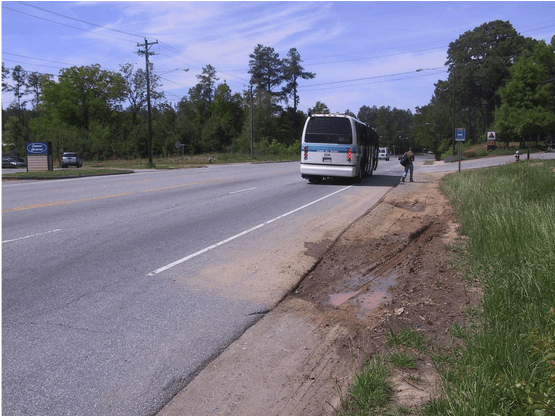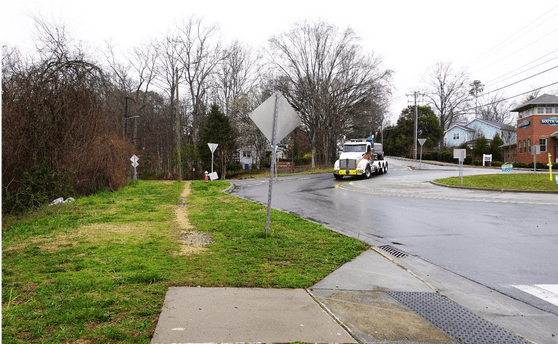If you walk, bike, or use transit to get around, chances are, you have experienced fear or a feeling of abandonment while waiting to cross a busy, high-speed road lacking a safe crossing, had to slog along a desire path next to traffic to reach a transit stop, or ride your bike next to trucks, buses, and rushing auto-commuters.

Gaps in sidewalks and biking paths and barriers to crossing major roads result in a lack of safety and dignity, and effectively deter many of us from choosing to travel on foot or by bike. Those lacking access to an automobile do not have a choice. A major objective of Chapel Hill’s Mobility and Connectivity Plan (2020) is to remove barriers to safe access for all types of travelers.

Unfortunately, scarce transportation dollars are available for local governments to tackle even urgent needs for pedestrians and cyclists.
On average, close to 94% of NC transportation funding is invested in highways and other ‘big roads’ across the state, leaving about 6 percent for ALL other modes of transportation: transit, pedestrian and bicycle, rail, ferries, and airports
(DeGood, 2022)
The key state-level policy that affects local funding is a law passed by the NC General Assembly in 2013, the NC Strategic Transportation Investment (STI) Law (STI LAW GS 136.89.11). This law prohibits spending State transportation dollars on stand-alone bicycle and pedestrian projects in our communities, or as the required match for bicycle and pedestrian projects that may qualify for federal grants. These restrictions limit the resources available for local communities to provide a more inclusive and accessible transportation system for all residents. You can see some of the backlog in the box below:
NC has a backlog of over 6,300 pedestrian and bike projects across the state
With NCDOT encouragement and planning grant support, 105 communities had developed and adopted 111 pedestrian, bicycle, or combined plans between 2013 and 2022. A report card issued by NCDOT lists over 6,300 projects identified as pedestrian and bicycle priorities among these plans, with less than one-fourth of projects across all plans having made progress. A primary barrier to implementation was a “lack of funding for project engineering, design and construction.”
Our region (thanks perhaps to skilled staffs, leadership, active community members, and a commitment to local funding such as through local bond issuance) has done better than other areas. Rural communities in the eastern and western parts of the State, which tend to be poorer and blacker, have made even less progress than other cities (NCDOT, 2023).
Currently, the prime way towns and cities can gain pedestrian and bicycle improvements using State transportation dollars is to plan multi-modal corridors that include other roadway “improvements”— usually more auto lanes—which may not be what the communities want or need.
More lanes generate more traffic over the longer term (Connect 2050) and lessen the safety and access for those walking, biking, and using transit. And, if local governments and residents are not paying close attention, these “multi-modal” corridors may not prove to be Complete Streets for all users.
How you can help
NCDOT’s transportation bill (House Bill 198) that would remove the funding restriction, is currently before the House of Representatives.
So now is a good time to advocate – with local elected officials, legislators, chambers of commerce, your Metropolitan Planning Organization (MPO) or Rural Planning Organization staff and boards, and other influencers who might have your ear – for a restoration of funding opportunities taken away by the 2013 legislation. Here is an example letter that you can adapt or use.
How to contact local officials
Durham Chapel Hill Carrboro Metropolitan Planning Organization: The list of board members is here.
Chapel Hill Town Council: Email [email protected] to reach the Mayor and all of Town Council
Carrboro Town Council: Email [email protected] to reach the Mayor and all of Town Council
Board of County Commissioners: Email [email protected] to reach all of the Orange County Commissioners
The Durham Chapel MPO prioritizes removal of this restriction and other policy barriers to help carry out the area’s long-range plans for a more balanced transportation system (Connect 2050, p. 71). The North Carolina Clean Transportation Plan (April 2023, p. 26, the State’s roadmap for reducing the transportation sector’s 36 percent of overall greenhouse gas emissions), also calls for removing legislative barriers to funding stand-alone bicycle and pedestrian projects.
Elimination of the STI Law restriction would restore the opportunity for bicycle and pedestrian projects to be considered for state funding.
Investment in active forms of transportation infrastructure is essential for the well-being of our communities, now and into the future. Continuation of the current transportation funding system will commit the residents of our state to suffering the negative consequences of these policies for a long time to come (DeGood, 2022).
Want to learn more?
For those seeking a fuller picture of transportation infrastructure funding in North Carolina, an article by Kevin DeGood (2022) of the Center for America Progress shows that about 94% of State funding has and will continue to flow to highway projects in the State until the current STI restriction and project prioritization criteria change. These policies severely limit the ability of the Triangle region and smaller communities across our State to provide a forward-looking transportation infrastructure that offers true alternatives to motor vehicle trips.
And, the Southern Environmental Law Center has posted a presentation, Transportation 101: A North Carolina Transportation Primer, on their website that provides a high-level description of transportation funding intricacies in our state
Endnotes/References
BikeWalkNC Call to Action, January 29, 2024, https://www.bikewalknc.org/2024/01/bikewalk-nc-call-to-action/
Connect 2050, The Research Triangle Region’s Metropolitan Transportation Plan, available at https://www.dchcmpo.org/home/showpublisheddocument/3842/637781272428930000).
DeGood, K., 2022, North Carolina’s Strategic Transportation Investments Law Is a Barrier to Progressive Transportation. CAP 20, available at: https://www.americanprogress.org/article/north-carolinas-strategic-transportation-investments-law-is-a-barrier-to-progressive-transportation/
NCDOT 2023 Summary Report, Measuring Progress of Bicycle and Pedestrian Plans in North Carolina, available at https://connect.ncdot.gov/municipalities/PlanningGrants/IMD-Multimodal-Planning-Program/Documents/NCDOT%20Annual%20Bicycle%20and%20Pedestrian%20Planning%20Grant%20Funds%20Report.pdf)
North Carolina Clean Transportation Plan, April, 2023, NCDOT, available at https://www.ncdot.gov/initiatives-policies/environmental/climate-change/Documents/nc-clean-transportation-plan-final-report.pdf
North Carolina General Assembly, House Bill 198, https://www.ncleg.gov/BillLookUp/2023/H198
Southern Environmental Law Center, January 23, 2024, Transportation 101: A North Carolina Transportation Primer, available at https://vimeo.com/909097674/940c8cafda?ts=0&share=copy
STI LAW GS 136.189.10 AND 136.89.11, available at https://www.ncleg.net/EnactedLegislation/Statutes/PDF/ByArticle/Chapter_136/Article_14B.pdf).
Town of Chapel Hill Mobility and Connectivity Plan, 2020 update, https://townhall.townofchapelhill.org/agendas/2020/10/28/20201023_Mobility_and_Connectivity_Plan.pdf
Other resources highlight how current state and federal transportation funding policy is hampering city, regional, and statewide goals for safer, cleaner, more equitable and climate-resilient, transportation infrastructure:
Clean Connected Communities, A North Carolina transportation primer from the Southern Environmental Law Center, available at https://vimeo.com/909097674/940c8cafda?ts=0&share=copy
NC Moves 2050 Plan, February 2021, available at https://www.ncdot.gov/initiatives-policies/Transportation/nc-2050-plan/Pages/default.aspx
State of North Carolina, Roy Cooper, Governor, Executive Order #246,
NORTH CAROLINA’S TRANSFORMATION TO A CLEAN, EQUITABLE ECONOMY, available at https://governor.nc.gov/executive-order-no-246/open
Making Federal Funding Work for Cities, March 2021, NACTO and Transportation for America, available at
https://nacto.org/wp-content/uploads/2021/03/Making-Federal-Funding-Work-for-Cities.pdf
The personal automobile is inefficient, environmentally and personally costly, and inequitable for moving people. Six percent of North Carolina households lack access to a motor vehicle; for Black households, it’s 12 percent (North Carolina Clean Transportation Plan, p. 13). In some Chapel Hill neighborhoods, 40 percent or more households do not own a car (https://townhall.townofchapelhill.org/agendas/2020/10/28/20201023_Mobility_and_Connectivity_Plan.pdf , p. 10).
